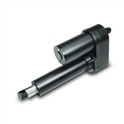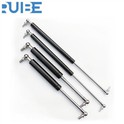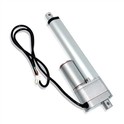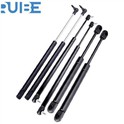Hey there! As a gas spring supplier, I often get asked about the wear resistance of gas springs. So, I thought I'd take a moment to break it down for you.
First off, let's talk about what wear resistance actually means in the context of gas springs. Wear resistance refers to a gas spring's ability to withstand the effects of friction, abrasion, and other forms of mechanical stress over time. A gas spring with good wear resistance will maintain its performance and functionality for a longer period, even under repeated use.
One of the key factors that affect the wear resistance of a gas spring is the quality of the materials used in its construction. For example, the piston rod is a critical component of a gas spring, and it's subjected to a lot of stress during operation. A high - quality piston rod made from materials like chrome - plated steel or stainless steel is more resistant to corrosion and wear. Chrome plating provides a hard, smooth surface that reduces friction between the piston rod and the seal, which in turn minimizes wear. Stainless steel, on the other hand, is known for its excellent corrosion resistance, making it a great choice for gas springs used in harsh environments.
The seal is another important part of the gas spring. A good seal not only prevents the leakage of gas but also reduces friction between the piston rod and the cylinder. Seals made from high - quality elastomers, such as nitrile rubber or fluorocarbon rubber, have better wear resistance. These materials can withstand high pressures and temperatures without losing their elasticity, ensuring a tight seal and smooth operation of the gas spring.
The design of the gas spring also plays a role in its wear resistance. Gas springs with a well - designed internal structure, such as a proper piston and valve system, can distribute the forces evenly during operation. This reduces the stress on individual components and helps to prevent premature wear. For instance, a gas spring with a balanced piston design will move more smoothly inside the cylinder, minimizing the chances of uneven wear.
Now, let's think about where gas springs are commonly used and how wear resistance matters in those applications.
Gas Spring for Kitchen Cabinet
In kitchen cabinets, gas springs are used to support the opening and closing of cabinet doors and drawers. They are constantly in use, and over time, they can experience a lot of wear. A gas spring with good wear resistance will ensure that the cabinet doors and drawers open and close smoothly for years to come. You can check out our Gas Spring for Kitchen Cabinet for options that are designed to handle the daily wear and tear in the kitchen.
Gas Spring for Storage Bed
Storage beds often use gas springs to lift the heavy bed frame for access to the storage space underneath. These gas springs need to be strong and have high wear resistance because they are supporting a significant amount of weight every time the bed is opened and closed. Our Gas Spring for Storage Bed is engineered to provide reliable performance and long - lasting wear resistance, so you don't have to worry about the gas spring failing prematurely.
Gas Struts for Tool Box
Tool boxes also rely on gas struts to keep the lids open. Since tool boxes are frequently opened and closed, the gas struts are subject to repeated stress. A wear - resistant gas strut will maintain its lifting force and ensure that the tool box lid stays open securely. Take a look at our Gas Struts for Tool Box to find a solution that can handle the demands of your tool box.
To test the wear resistance of gas springs, manufacturers usually conduct various types of tests. One common test is the cycle test, where the gas spring is opened and closed a certain number of times to simulate real - world use. The performance of the gas spring is monitored throughout the test, and any changes in parameters such as force, stroke length, or leakage are recorded. Another test is the salt spray test, which is used to evaluate the corrosion resistance of the gas spring components. By exposing the gas spring to a salt - laden environment, manufacturers can determine how well the materials can withstand corrosion over time.
As a gas spring supplier, we take wear resistance very seriously. We use high - quality materials, advanced manufacturing processes, and strict quality control measures to ensure that our gas springs have excellent wear resistance. Our R & D team is constantly working on improving the design and materials of our gas springs to meet the ever - increasing demands of our customers.
If you're in the market for gas springs, whether it's for kitchen cabinets, storage beds, tool boxes, or other applications, you need to consider wear resistance. A gas spring with good wear resistance will save you money in the long run by reducing the need for frequent replacements.


So, if you're interested in our gas springs and want to learn more about how they can meet your specific needs, feel free to reach out to us. We're always happy to have a chat about your requirements and help you find the right gas spring solution. Whether you're a DIY enthusiast or a professional in the industry, we've got the products and expertise to support you.
References
- "Gas Spring Design and Application Handbook"
- Technical papers on gas spring materials and manufacturing processes from industry conferences.






